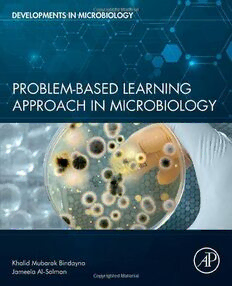
Problem-Based Learning Approach in Microbiology PDF
Preview Problem-Based Learning Approach in Microbiology
1 Problem-Based Learning Approach in Microbiology Khalid Mubarak Bindayna Microbiology, College of Medicine, Arabian Gulf University, Manama, Kingdom of Bahrain Jameela Al-Salman Ministry of Health, Manama, Kingdom of Bahrain 2 Table of Contents Cover image Title page Copyright Dedication Acknowledgment How to use this book Chapter 1. Basic concepts in microbiology and immunology Abstract Contents Problem number 1.1: antibiotics Diagnosis Treatment Follow-up and outcome Question and answer Learning objectives Discussion Key take-aways 3 Problem number 1.2: sterilization Question and answer Learning objectives Discussion Key take-aways Problem number 1.3: fever Diagnosis Treatment and support Follow-up and outcome Question and answer Learning objectives Discussion Key take-aways Problem number 1.4: food poisoning caused by Shigella flexneri Diagnosis Treatment Follow-up and outcome 4 Question and answer Learning objectives Discussion Etiological agent Key take-aways Problem number 1.5: immunodeficiency Diagnosis Treatment and therapy Follow-up and outcome Question and answer Learning objectives Discussion Key take-aways References Chapter 2. Infections of the central and sensory nervous system Abstract Contents 5 Problem number 2.1: Tetanus caused by Clostridium tetani infection Diagnosis Treatment Question and answer Learning objectives Discussion Etiological agent Key take-aways Problem number 2.2: Shingles caused by herpes zoster virus infection Diagnosis Treatment Question and answer Learning objectives Discussion Etiological agent Key take-aways Problem number 2.3: Preseptal cellulitis caused by Hemophilus 6 influenzae infection Diagnosis Treatment Question and answer Learning objectives Discussion Etiological agent Key take-aways Problem number 2.4: Subdural empyema caused by Streptococcus pyo- genes infection Diagnosis Treatment Question and answer Learning objectives Discussion Etiological agent Key take-aways 7 References Chapter 3. Infections of the gastrointestinal and hepatobiliary system Abstract Contents Problem number 3.1: Klebsiella pneumoniae liver abscess caused due to Klebsiella pneumoniae infection Diagnosis Treatment Question and answer Learning objectives Discussion Discussion Etiological agent Key take-aways Problem number 3.2: Liver failure caused by cytomegalovirus-induced hepatitis Diagnosis Treatment 8 Question and answer Learning objectives Discussion Etiological agent Key take-aways Problem number 3.3: Ulcerative colitis caused by rotavirus infection Diagnosis Treatment Follow-up and outcome Question and answer Learning objectives Discussion Etiological agent Key take-aways Problem number 3.4: Gastric ulcer caused by Helicobacter pylori Diagnosis Treatment 9 Follow-up and outcome Question and answer Learning objectives Discussion Etiological agent Key take-aways References Chapter 4. Infections of the respiratory system Abstract Contents Problem number 4.1: Community-acquired pneumonia caused by Streptococcus pneumoniae Current (on-going) medications Diagnosis Treatment Question and answer Learning objectives 10
